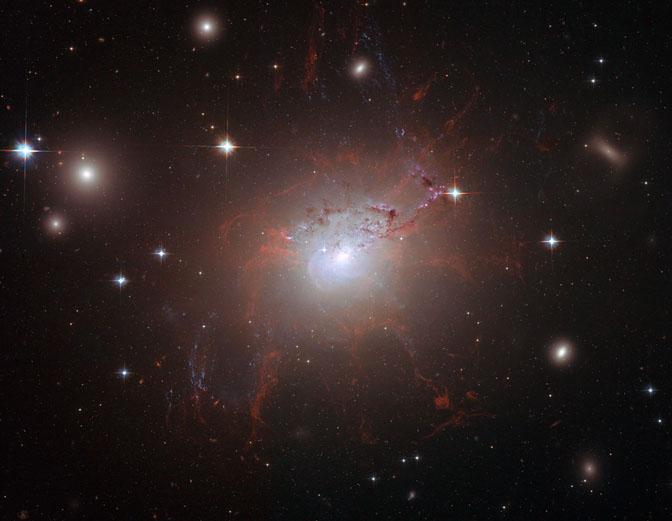
home •
about •
essential guide •
picture of the day •
thunderblogs •
news •
multimedia •
predictions •
products •
get involved •
contact
picture of the day archive subject index
Galaxy NGC 1275. Credit: NASA, ESA and Andy Fabian (University of Cambridge, UK)
Aug 25, 2008
Forever Blowing BubblesThe Hubble Space Telescope team refers to the active elliptical galaxy NGC 1275 in the nearby Perseus Cluster as a “magnetic monster” with a black hole at its core. However, the filamentary structure indicates electrical activity.
NGC 1275 “blows bubbles” and drags filaments of “cold gas” into the surrounding “multi-million degree X-ray emitting gas” according to astronomers. Magnetic streamers, or filaments, are said to confine the cold gas. The filaments are “a challenge for astronomers” to explain why they haven’t evaporated in the hot gas or collapsed into stars from their own gravity or been disrupted by tidal forces from other galaxies in the cluster. The filaments are calculated to be 200 light-years thick and up to 20,000 light-years long (assuming that the galaxy is at its “cosmological redshift distance”).
As has become usual when confronted by such filamentary structures, astrophysicists meet the challenge by dropping onto the explanatory stage the deus ex machina of magnetism – without acknowledging that electric currents generate magnetic fields. (Such an acknowledgement, of course, would undermine the consensus dogma that Gravity is God.)
But even in consensus dogma, a “multi-million degree X-ray emitting” substance can’t be a “gas” – it is plasma. Only by ignoring the properties of plasma, which have been known and demonstrated in labs for a century, can astrophysicists maintain their fantasy.
An awareness of plasma requires, at least, comparison of the “bubbles” with Coronal Mass Ejections (CMEs) on the Sun. As the current that is driving a double layer (DL) increases, the DL becomes unstable and expands, often accelerating, as it gets larger. The current along the DL generates a magnetic field that pinches the plasma within it into a thin filament. Because the forces that confine the filament are self-generated at each point along the filament, it is unaffected by the much weaker forces of evaporation, gravitational collapse, and tidal disruption. It can remain coherent over distances that are orders of magnitude greater than its thickness.
The Electric Universe proposes a bigger picture: An active galaxy is the center of a plasma pinch in an intergalactic current. The X-rays are not being emitted from a “hot gas” but are synchrotron radiation emitted by electrons spiraling in the direction of the magnetic field. Instead of a black hole powering the emissions and filaments, there is a plasma focus mechanism powered by the intergalactic current.
Because plasma phenomena are similar at all scales, NGC 1275 would be a galactic-scale version of a planetary nebula. The rough circular symmetry we see is due to the galaxy’s orientation with its axis along our line of sight: We’re “looking down the barrel” of an hourglass-shaped electrical discharge.
By Mel Acheson
_______________________________________________________________________
Please visit our new "Thunderblog" page
Through the initiative of managing editor Dave Smith, we’ve begun the launch of a new
page called Thunderblog. Timely presentations of fact and opinion, with emphasis on
new discoveries and the explanatory power of the Electric Universe."The Electric Sky and The Electric Universe available now!

|
|

|
EXECUTIVE EDITORS:
David Talbott, Wallace Thornhill
MANAGING EDITORS:
Steve Smith, Mel Acheson
CONTRIBUTING EDITORS: Michael Armstrong, Dwardu Cardona,
Ev Cochrane,
C.J. Ransom, Don Scott, Rens van der Sluijs, Ian Tresman
WEBMASTER: Brian Talbott
Copyright 2007: thunderbolts.info
![]()
home •
thunderblogs •
forum •
picture of the day •
resources •
team •
updates •
contact us

